(PCC) Program on Chinese Cities – Thoughts on Overseas Travels Series
Authors: Shen Duanshuai,
School of Government Management, Beijing Normal University, Doctoral Candidate; Department of City and Regional Planning, University of North Carolina at Chapel Hill, Visiting Scholar. shenduanshuai@mail.bnu.edu.cn
Zeng Li,
Wenzhou Branch, Yingke Law Firm, Full-time Lawyer; Department of City and Regional Planning, University of North Carolina at Chapel Hill, Visiting Scholar. lize@unc.edu
On January 16, 2024, a public hearing regarding changes to land use planning and zoning in the city of Durham, North Carolina, took place as scheduled at the Durham City Council. The public hearing offered two ways for the public to listen in: attending in person or watching online (via YouTube live stream)/participating (via Zoom meeting). The author originally chose to go to the Durham City Council to experience the atmosphere of the public hearing in person, but heavy rain that day ultimately forced us to choose to listen online (Image 1).
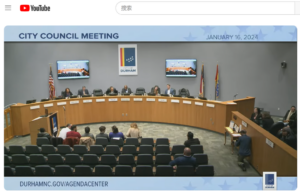
Public participation in American social governance has always been a perennially discussed topic [1-3]. Regarding public participation in the field of American land use planning, as early as 2017, Teacher Tan Ronghui, who was visiting the University of North Carolina at Chapel Hill (UNC-Chapel Hill), combined his coursework to write the article ‘How to Prevent Planning from Being Merely ‘Drawing on Maps, Hanging on Walls’?’ [4]. After reading this article, it’s striking how time flies; 7 years later, the topic of ‘American public participation’ still attracts the collective attention of UNC visiting scholars.
The author is deeply aware of the importance of ‘public participation’ on every scale from national construction to community governance and also understands that the intensity and form of public participation show significant differences across different countries and regions. We attribute these differences to differences in ‘place/placeness.’ ‘Placeness’ is a geographical concept referring to the innate characteristics that differentiate one place from another [5]. Typically, the placeness of a location comes from three sources: ‘the first is the immovable mountains and rivers of the place, the second is the combination of physical elements that have been accumulated over time, and the third is the historical events that have occurred there’ [6]. The existence of placeness shapes the local context. This further reminds us that when observing or thinking about the topic of American public participation, we need to start from the local context of the United States to understand the processes and mechanisms of public participation. To facilitate explanation, the author adopts the narrative framework of ‘Context – Structure – Action – Outcome’ [7], connecting the multiple feelings after participating in the entire public hearing.
1 Context: Emphasis on a social atmosphere of multi-actor governance
The process of social governance in the United States emphasizes the absorption of social forces and stresses multi-actor collaborative governance. Multi-actor governance involves the participation of government, private sector, non-profit organizations, community groups, and citizens, aiming to achieve a more effective and inclusive decision-making process through cooperation and coordination. For example, the research on multi-actor governance conducted by Elinor Ostrom, based on a series of American cases, highlights the complexity and diversity of public resource management and reveals the importance of multi-actor participation in improving the efficiency of public resource management, promoting fairness, and enhancing governance transparency [8]. Public participation in American land use planning is a vivid reflection of multi-actor governance, emphasizing community involvement and encouraging residents to voice their opinions in the planning decision process. This practice helps ensure that projects reflect the needs and values of the community and increases the likelihood of project success. Furthermore, American social governance emphasizes transparency and government accountability, which requires government agencies to open their decision-making processes to the public, provide information, allow the public to monitor government actions, and raise questions when necessary. This requirement for transparency ensures that the public is fully informed about ongoing planning and policy-making processes, thereby enabling more effective participation.
2 Structure: Collaborative governance among the public, government, and planners
The governance structure in the process of land use planning in the United States typically involves multi-level government agencies and broad public participation. This process emphasizes the principle of local autonomy, where even though the federal and state governments set some basic guidelines and legal frameworks, the majority of decision-making and implementation authority for land use planning still resides with local governments. In the United States, local governments bear the primary responsibility for formulating and implementing land use plans. These local governments manage and guide land use and development through comprehensive plans, zoning regulations, and other planning policies. The governance structure in the process of land use planning in the United States reflects the spirit of local autonomy under the principle of federalism, ensuring the democracy, transparency, and accountability of land use planning through a multi-layer governance system and public participation.
Public participation holds a central place in the governance structure of land use planning in the United States, key to ensuring the democratization, transparency, and inclusiveness of the planning process. This participation not only reflects the importance placed on citizen involvement in decision-making processes in a democratic society but also helps improve the quality and acceptability of planning, ensuring that planning outcomes reflect the needs and visions of the community. Public participation ensures that the land use planning process is open to all stakeholders, thus increasing decision-making transparency. This openness helps citizens understand the imminent changes and their potential impacts, enhancing the democracy of the entire planning process. Through public meetings, workshops, surveys, and other participatory mechanisms, planners can collect information directly from community members, understanding their needs, preferences, and concerns. This direct feedback mechanism ensures that planning decisions better reflect and meet the actual needs of the community.
Public participation helps integrate diverse perspectives and expertise into the planning process, improving the quality and innovation of planning schemes. Community members may propose solutions and ideas that planners have not considered, helping to create more comprehensive and sustainable land use plans. When the public participates in the planning process, they are more likely to support and identify with the final planning decisions. This sense of involvement and belonging helps reduce resistance in subsequent implementation stages, ensuring the smooth execution of planning. Overall, public participation plays a crucial role in the governance structure of land use planning and implementation in the United States, not only as a means to promote transparent and democratic decision-making but also as an important way to improve planning quality, promote community development, and enhance public satisfaction.
3 Action: Diverse platforms and pathways for public participation
In the process of formulating and implementing land use planning in the United States, public participation takes many forms to ensure that the planning process is transparent, fair, and fully reflects the wishes and needs of community members (Figure 2). Here are some specific ways of public participation.
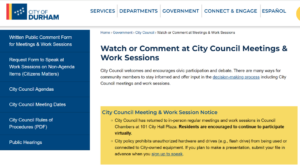
(1) Public meetings and hearings. Local governments regularly hold public meetings and hearings during the planning formulation and implementation process, where they introduce planning proposals, policy changes, or development projects, and listen to public opinions. These meetings provide a platform for community members to communicate directly with decision-makers.
(2) Workshops and public forums. By hosting workshops and public forums, planners can engage in in-depth exchanges with community members to discuss specific planning issues or projects. These events are often more interactive, and designed to encourage active public participation in the discussion and decision-making process.
(3) Online surveys and questionnaires. Collecting public opinions using online tools is an effective way to participate. Government agencies and planning organizations conduct online surveys and questionnaires to understand community preferences, concerns, and suggestions. This method facilitates the collection of a large amount of data and can reach a wider audience.
(4) Social media and digital platforms. Social media and other online platforms provide new avenues for public participation. Through these platforms, governments and planning organizations can post updates, solicit feedback, and interact with community members.
(5) Community advisory groups. Some planning projects establish community advisory groups, inviting community representatives and stakeholders to participate in more in-depth discussions. These groups help to focus on specific issues and provide expert and local insights for planning decisions.
(6) Submission of written opinions. The public can also participate in the planning process by submitting written opinions. This includes sending individual or group opinions and suggestions to the planning department via email, letters, or online forms.
(7) Use of maps and visual tools. In some public participation activities, planners use maps, models, and visualization tools to help the public better understand planning proposals and potential impacts. This method helps to facilitate more effective communication and understanding.
4 Outcome: Enhancing the Overall Well-being of the Community
In American land use planning, public participation has had a profound impact on enhancing community well-being. This participation ensures that the planning process reflects not only the insights of professional planners but also integrates the needs, desires, and priorities of community members. Public participation enables planners to directly understand the needs and expectations of community members, thereby creating planning schemes that are more closely aligned with the actual needs of the community. This direct response to needs helps to optimize public services, living conditions, transportation facilities, and recreational spaces, directly improving residents’ quality of life. Participating in the planning process promotes communication and cooperation among community members, establishing common goals and visions. This collective participation process helps to strengthen community cohesion, foster mutual support and joint development among residents, and build a more unified and harmonious community environment. During the public participation process, community members often emphasize the importance of environmental protection and sustainable development. For instance, the public hearing held in Durham this time focused on issues such as the siting of Durham’s water sources (Figure 3, Figure 4), and the public voted on such matters (Figure 5). This prompts planning decisions to give more consideration to green spaces, reduce pollution, and protect natural resources, helping to improve the community’s environmental quality and provide a healthier and more livable living environment for residents.
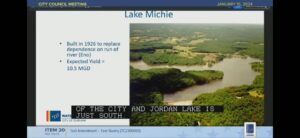
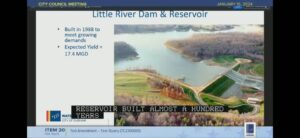
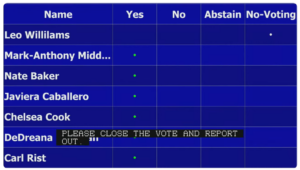
In summary, public participation in American land use planning not only enhances the democracy and transparency of the planning process but also directly and indirectly improves community welfare in various ways, including improving the quality of life, and the environment, promoting social justice, and economic development.
Note: All images in the text are sourced from the public hearing’s YouTube live stream at https://www.youtube.com/watch?v=JrF4HuTttLo&ab_channel=CityofDurhamNC.
